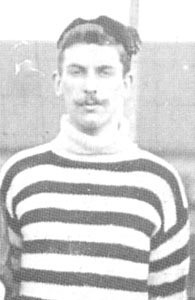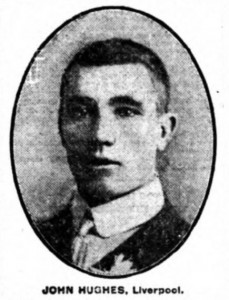CURIOUS FACTS ABOUT FULL INTERNATIONAL AND NATIONAL PLAYERS (1905)
Picture : Switzerland’s international debut against France in Paris (February 12, 1905)
Interesting and curious facts about full internationals and national players (1905)
————————————————————————————————————–by IFFHS—
1905
When Switzerland made their international début – against France (0:1), at the Parc des Princes in Paris on February 12, 1905 – the Swiss FA paid the players’ train fares (third class) and gave each 12.60 Swiss francs spending money. However, captain and centre forward Eduard Garonne returned the spending money, as by the statutes of his club, the Zürich “Grasshoppers”, he was not allowed to accept money.
——-
Donald McLeod, born in Laurieston near Falkirk on May 28, 1882, played for Stenhousemuir before he joined Glasgow Celtic in 1902, where he developed into a strong and resolute right full-back. From 1905 to 1906 he played for Scotland four times. From October 1908 to 1913, he played in Middlesborough (England). During World War I he was a gunner with the Royal Field Artillery. He fell in Belgium on October 6, 1917, at the age of 35.
——
When Scotland played Ireland (4:0) in Glasgow on March 18, 1905, their left full-back was William McIntoshfrom Third Lanark. At the end of the season (1905/06), he transferred to local rivals Partick Thistle (Glasgow). He emigrated to Canada before the outbreak of World War I, where he made a career in politics and by the mid-1930’s had advanced to regional government in Edmonton (Alberta).
——
John Lyall(16.4.1881-19.2.1944), a very safe goalkeeper, was born in Dundee. In 1901 he transferred fom Jarrow to Sheffield Wednesday (England), with whom he won the English championship in 1903 and 1904, and the English Cup in 1907. From 1909 to 1911 he played for Manchester City, and from then until 1914 for Dundee FC. In 1905 he played for Scotland once (1:0 England). He also emigrated to North America, where he worked in Canada as a plasterer, but died in the USA.
——
On April 30, 1905, Eric Thornton(an Englishman living in Belgium) kept goal for Belgium against the Netherlands. When on May 7, 1905, France came to Brussels to play Belgium, they protested against Belgium fielding an English goalkeeper. Thus the match was delayed one hour, for Belgium had to get another goalkeeper, Robert Hustin of Racing Club de Bruxelles. This match was to be controlled by English referee John Lewis, but the coach which was to get him from the railway station had badly lost its way, and Lewis only arrived 15 minutes after kick-off – after the match had been delayed one hour. He took over from Belgian Rodolf Williams Seeldrayers(later FIFA president), under whose direction the match had remained scoreless. In the end, the guests won 7:0.
Eric Thornton Foto: IFFHS
——
Belgium had started this full international with ten players, as centre forward Gustave Vanderstappen of Union St.-Gilloise only arrived at Vivier d’Oie some minutes after kick-off. This field, the home ground of Racing Club de Bruxelles, was located in the then still autonomous south Brussels commune Uccle (Ukkel). Due to the one-hour delay, caused by the above-mentioned protest, French goalkeeper Georges Crozier of Union Sportive Parisienne had to leave the field in the 65th minute, the score standing at 0:4, so as to catch the train and be back at the barracks in time, as he was then doing military service. Thus France played on short-handed. Captain and full-back Fernand Canelle, who had replaced Crozier in goal, conceded another three. French wing half-back Charles Wilkes – who played for France’s oldest football club, Havre Athletic Club (founded in 1872) – came from the Channel Islands, but had since taken on French citizenship.
——
In 1905, half-backs Edwardand John Hughes– who were not related – played together in all three of Wales’ full “A” internationals. “Teddy”, born in Ruabon in 1876, played for the “Spurs” (London) from 1899 to 1908, and from 1899 to 1907 also played 14 times for Wales. The centre-half, who was creative and strong in the air. “Jack Geezer” Hughes, who was born in Flint in April 1877, also played in England (Liverpool FC), from 1903 to 1906. The wing half-back only played for Wales three times, the above-mentioned matches in 1905. His career was cut short by an injury which he sustained in 1908 while playing for Plymouth Argyle. He was said to have family ties with Ireland, and before the full “A” international in Belfast on April 8, 1905 (2:2 Ireland), the Irish FA required him to prove his nationality before he was allowed to play for Wales.
——
Welsh outside left in 1905 was either Alfred Oliver(Bangor FC) or Robert Atherton (Middlesbrough FC). Alfred Oliver was born in Bangor on September 15, 1882, and except for the 1905/06 season (Blackburn Rovers) played for Bangor FC from 1903 to 1914, but only twice for Wales, in 1905. At the age of 11, he had stayed with his grandfather at Min y Don (Anglesey), where he attended the Beaumaris Grammar School. After World War I, Alfred Oliver still played for Llandegfan and worked in the construction business. He died in Glyn Garth (Menai Bridge, Anglesey) on March 29, 1963. His son Glyn Oliver was an aerospace designer in the USA, where he also worked on Project Apollo (moon landing).
——
Robert Athertonwas born in Bethesda (Caernarfonshire) on July 29, 1876, but spent his childhood in Scotland, where he also attended school and high school and started playing football for Dalry Primose. He then joined Heart of Midlothian FC (Edinburgh), and in 1898 transferred to local rivals Hibernian FC. In 1903 he went to England, where he played for Middlesbrough, and from 1906 on for Chelsea (London). From 1899 to 1905 he played for Wales nine times. “Bob” Atherton, who served on a submarine during World War I, was killed in action in the English Channel in November 1917.
——
John Tracey, born in Llandysilio (Mongomeryshire) on August 24, 1876, started as a centre forward for St. Martin’s. When one day the goalkeeper was absent, “Tracey” replaced him, and from then on always kept goal. He then went on to play for Chirk AAA (1898-1900), Oswestry, Druids FC (Ruabon) (1902-1904) and Wrexham. After his first transfer, he was a reserve for three years. During his first full season (now with Druids) he held 12 of the 18 penalties awarded against his side, and in 1905 played once for Wales (2:2 Ireland, in Belfast). In 1906 he was found to have been a professional and was disqualified. After a one-year break he adopted his uncle’s name “Morgan”, and in 1907 went back to playing for the same club, which kept his secret. The last clubs he played for were Chirk AAA and Chester (1910/11). Thus he entered the annals of Welsh football as John Tracey Morgan. By profession he was a underground mine manager in Chirk, and also spent some time working in a coal mine in China.
——
Ireland’s goalkeeper against Wales (2:2) on April 8, 1905, was Robert Reynolds of Bohemians FAC (Dublin). During the same, he had won the Irish cycling championship. This was the only match he ever played for Ireland.


